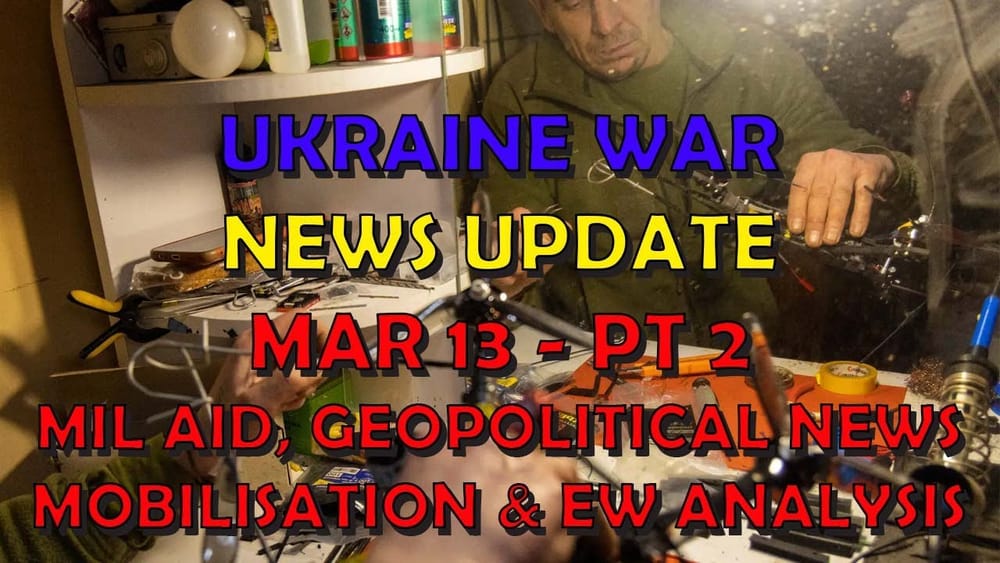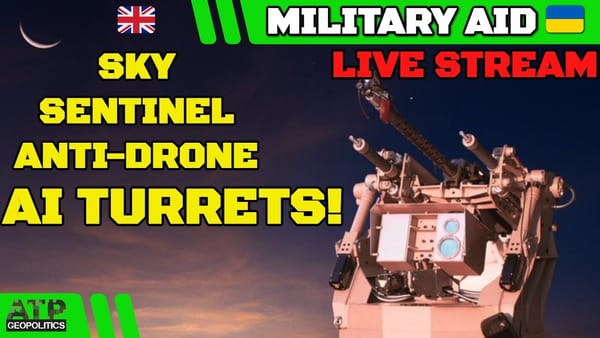Ukraine War Update NEWS: Military Aid & Geopolitical News, Max Boot on Trump
Table of Contents 📖
"You either give your life to this or you give your money to this you know take your choice choice there because we are fighting an existential war where none of this will exist like your job won't exist if we if we are properly invaded"
Hello Team
🎦 00:00-02:39⏩
Jonathan welcomes viewers to the second part of the Ukraine War Update for the 13th of March 2024. He notes the ongoing attacks on Russian oil refineries in Belgorod and Kursk regions. He highlights the Novoshtkiy oil products plant in Rostov Oblast being hit, with conflicting accounts from the Russian governor. He also mentions a fifth fatality in the Krivy Rih missile strike and calls for evacuation from Kursk and Belgorod due to the ongoing attacks.
Return to top⤴️
Ukraine Plans to Mobilise 500,000 People
🎦 02:39-15:06⏩
Jonathan discusses a Financial Times article outlining Ukraine's plan to mobilise 500,000 people.
- 330,000 will replace exhausted troops, while the remaining recruits will address losses and evolving needs.
- A new mobilisation law, facing over 4,000 amendments, aims to update the legal framework for this recruitment wave.
- The article highlights the sensitivity surrounding mobilisation, with a significant portion of men reluctant to fight despite supporting the war effort.
- Jonathan analyses an infographic revealing a limited pool of eligible men, further complicated by factors like those living abroad or working in critical roles.
- He explores the proposed economic reserve system, where exempt individuals contribute financially, sparking debate about potential elitism.
- Jonathan acknowledges the financial burden, with the new wave estimated to cost $208 billion in 2024, exacerbating Ukraine's existing budget deficit.
- He contrasts this with Denmark's $330 million aid package, highlighting the disparity in contributions.
US Aid to Ukraine and Discharge Petitions
🎦 15:07-18:25⏩
Jonathan provides an update on US aid to Ukraine, focusing on two discharge petitions circulating in the House of Representatives.
- He explains that these petitions require 218 votes to pass, with both Democrats and Republicans pushing separate versions.
- Jonathan analyses the potential roadblocks, highlighting that Republicans favouring Ukraine aid might prioritize their party's version, while some Democrats oppose the inclusion of aid to Israel within the bill.
- He expresses cautious optimism about the petitions' chances, noting that securing enough signatures from both sides of the aisle remains a significant challenge.
International Military Aid Updates
🎦 18:25-23:22⏩
Jonathan delivers a roundup of international military aid updates.
- He reports that the US is preparing a new military aid package, initially announced as $400 million, but now believed to be closer to $300 million. The package is expected to include Stinger anti-aircraft missiles, ammunition for High Mobility Artillery Rocket Systems (HIMARS), and 84 anti-armor systems.
- He then highlights Denmark's announcement of a $330 million package, which includes 155mm Caesar artillery systems (co-financed with France), 120mm self-propelled mortars, and additional artillery shells.
- Jonathan notes that the EU is close to finalizing a €5 billion military aid package for Ukraine after months of discussions about procurement rules.
- He further reveals that Ukraine is set to receive €6.5 billion in EU transitional financing, with €4.5 billion disbursed in March and the remainder in April, contingent on meeting agreed-upon indicators.
- Lastly, he mentions the Czech Republic's pledge to provide Ukraine with an additional 200,000 artillery shells on top of the already promised 300,000, potentially funded by Norway.
Germany Puts Taurus Missiles on Combat Readiness
🎦 23:22-27:06⏩
Jonathan discusses Germany's decision to put all its long-range Taurus missiles on combat readiness, as reported by De Welt.
- He notes that Germany possesses around 600 of these missiles, with only half currently operational.
- While German Chancellor Olaf Scholz previously opposed sending Taurus missiles to Ukraine, Jonathan speculates that this move could indicate a potential transfer to the UK as part of the Ringtausch rotation.
- He also touches upon Germany's efforts to support Ukraine's Gepard anti-aircraft systems, with Rheinmetall ramping up production of ammunition.
- Germany has already supplied 40,000 rounds, with an additional 110,000 to be delivered soon, and a further 150,000 planned.
- Jonathan ponders the cost of individual rounds for both small arms and larger systems like the Gepard, emphasizing the significant financial implications of supplying such quantities.
Ukraine Begins Mass Production of Brave One Robotic Platforms
🎦 27:06-27:57⏩
Jonathan reports that Ukraine has commenced mass production of the "Brave One" robotic ground platform.
- He mentions that over 50 units have already undergone testing, demonstrating capabilities in various roles, including acting as kamikaze platforms, mobile turrets, mine layers and clearers, casualty evacuation, and ammunition transport.
- He distinguishes these UGVs (unmanned ground vehicles) from UAVs (unmanned aerial vehicles) and USVs (unmanned surface vehicles).
UK Tests DragonFire Long-Range Laser Weapon
🎦 27:57-29:04⏩
Jonathan discusses footage released by the UK Ministry of Defence showcasing tests of the DragonFire long-range laser weapon.
- This high-tech weapon boasts remarkable accuracy, capable of hitting a coin-sized target at a distance of one kilometer.
- He notes that firing the laser is said to cost only £10, making it a potentially game-changing and cost-effective solution for countering threats like drones.
- He shares Anton Gerashchenko's claim that Ukraine is ready to test the DragonFire in combat, but casts doubt on the UK's willingness to release such cutting-edge technology, especially given its limited availability.
Electronic Warfare Reshaping Ukraine's Battlefields
🎦 29:05-32:35⏩
Jonathan delves into a New York Times article exploring the impact of electronic warfare in the Ukraine conflict.
- He highlights that Russia holds a significant advantage in this domain, possessing more powerful and coordinated jamming equipment capable of disrupting Ukrainian communications.
- This poses a challenge for Ukraine's increasing reliance on drones, which are vulnerable to Russian jamming efforts.
- He notes that while Western military aid remains uncertain and artillery ammunition runs low, the pressure on Ukraine's unmanned aerial capabilities will only intensify.
- He contrasts the centralised and well-established nature of Russia's electronic warfare program with Ukraine's more decentralised approach, which relies on diverse groups, including the country's IT sector.
- Jonathan argues that this decentralized structure, while fostering innovation, can also lead to coordination challenges and vulnerabilities.
- He further explains that the limited availability of analog frequency channels for commercially available FPV (first-person view) drones presents another obstacle, leading to potential interference and control issues amidst the saturation of drone operations in the conflict zone.
Wrap up
🎦 32:35-32:41⏩
Jonathan concludes the military aid and equipment segment, acknowledging its length due to the significant volume of information. He thanks viewers and promises to return with a geopolitical news video soon.
Return to top⤴️



